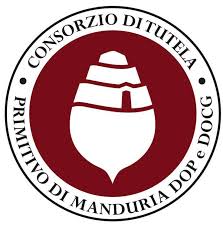Primitivo di Manduria Dolce Naturale DOCG Appellation
Protected Designation of Origin (PDO)


Manduria DOC.
In the plain of Manduria the Primitivo most likely landed at the end of the nineteenth century, thanks to some cuttings brought by the Countess Sabini of Altamura, married to Tommaso Schiavoni Tafuri, who started its cultivation in the lands of his property, saddles dunes of Campomarino , a coastal town fraction of Maruggio.
The first label of which there is evidence of the primitivo coming from the Schiavoni Tafuri vineyard dates back to 1891 and bears the name “Campo Marino”. It is said that the nobleman of Manduria was so jealous of this wine, which soon revealed itself to be of great structure, that he admitted to the tasting only a few chosen friends of his. All this obviously does not exclude that the vine had been present for some time in Puglia, on the Bari Murgia or along the Ionian-Tarantino area (Baldassarre, 2003).
The fame in Roman times of the Taranto area or Aulonia appears singular, praised for fertility and abundance in the Ode VI of the Carmina di Orazio: “More than any other corner of the earth / the one where honey is no less than that of Imetto / and the olive tree competes with that of Venafro / where Jupiter alternates long springs and warm winters / and the Aulone, friend of the fertile Bacchus, is in no way inferior to the Falerno grapes ”.
The mere tarantina, the prestigious wines produced in the territory of ancient Aulonia, were compared by Orazio to the famous Falerno, whose qualities of longevity, austerity and strength were reproduced. The legendary comparison between the two wines, in supporting the thesis of a contribution of Primitivo to their composition, is supported by the recognition of the ancient presence of the vine in the Caserta area, in the same area where the famous Falerno was produced in Roman times, with the DOC “Falerno del Massico Primitivo”. To this reference Vitagliano notes “The fact that in this same area of the province of Caserta, locally, the vine is calledprimitivo di Lecce suggests that it somehow came from Puglia, and in particular from Salento”.
In 1629, the Monopolitan patrician Prospero Rendella in his “Tractatus de vinea, vindemia et vino” praised the qualities of Tarentinum wine. And such a prestigious wine necessarily had to come from a vineyard with superior qualities and strongly adapted to the environment. And then one could also think that the Primitivo brought to Manduria by the Countess Sabini of Altamura marked a fortuitous return of a vine widespread in the same area in a much more remote period.
The recent work “From Merum to Primitivo di Manduria”, in the valiant attempt to reconstruct the millenary intertwining between the history of the Apulian people and wine, adds interesting pieces to the thesis of an ancient presence of the Primitivo vine in the Manduria area or at least of a similar one (Filo et al., 2004). The book describes the fame of the so-called “pessima fair” of Manduria, known in the Angevin period for the goodness and abundance of the wine that came from the neighboring municipalities and speaks of Abbot Pacichelli, who during his travels d’Otranto in the last decades of the 17th century, he stopped to observe the great oenological production of Casalnuovo, today’s Manduria. Its phenological life is shorter than other varieties: despite its early ripening, it is,
A unique feature in the viticultural panorama, the so-called feminelle, in the area called racemes, reach perfect ripeness after the first harvest. In fact, about a month after the first harvest, the racemes were harvested, which certainly represented different characteristics from the main bunches, nevertheless the resulting must was vinified in purity and the wine obtained was drier and more tannic as well as more colored than that coming from the first harvest.
Over the centuries, viticulture has maintained its role as the main crop of the territory, right up to the present day.The DOCG “Primitivo di Manduria Dolce Naturale” was recognized with the Ministerial Decree 23/02/2011 – GU n. 57 of 03/10/2011.
Territory
The territory in which the production area of the D.O.C.G. Primitivo di Manduria Dolce Naturale is essentially characterized by two types of landscape: the Ionian Arch and the Salento peninsula.
The Arco Ionico mainly affects the coastal area and extends from the Ionian coast to the base of the Murge, west to the Fossa Bradanica and east to contact with the North-Western Salento.
Salento (or Salento Peninsula) covers the south-eastern part of the entire Taranto area. It looks like a rather complex territory in which sub-flat surfaces alternate (in the areas located between Lecce and Brindisi) with calcareous reliefs (Salento greenhouses).
The Production Area of the DOCG Primitivo di Manduria Dolce Naturale wine is located in:
– province of Taranto and includes the territory of the municipalities of Manduria, Carosino, Monteparano, Leporano, Pulsano, Faggiano, Roccaforzata, San Giorgio Jonico, San Marzano di San Giuseppe, Fragagnano, Lizzano, Sava, Torricella, Maruggio, Avetrana and that of the hamlet of Talsano and the administrative islands of the municipality of Taranto, included in the territories of the municipalities of Fragagnano and Lizzano.
– province of Brindisi and includes the territory of the municipalities of Erchie, Oria and Torre S. Susanna.
Vinification and Aging
During the vinification phases, only loyal and constant oenological practices of the area are allowed, suitable to give the wines their peculiar quality characteristics.
The oenological practices of vinification of the DOCG Primitivo di Manduria Dolce Naturale include, among other things, that:
– The maximum yield of grapes into wine must not exceed 60%, equal to a maximum yield of 42 hl / hectare. for both types of Dolcetto di Diano d’Alba. If these parameters are exceeded, the right to DOCG for the whole product is lost.


